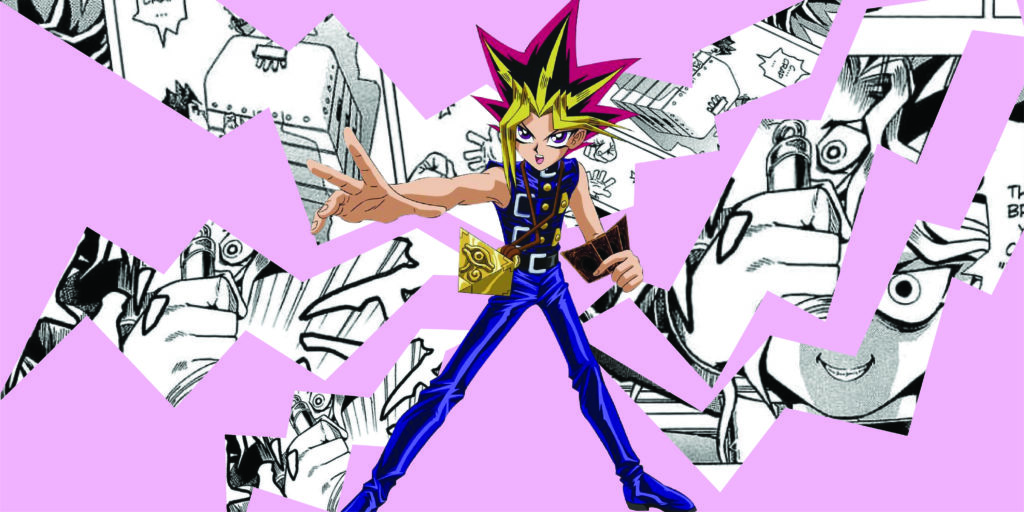The first time in my life I felt summoned to something — before writing, before love — I received an invitation to the Duelist Kingdom. It arrived in the mail: a VHS tape and letter from Maximillian Pegasus, CEO of Industrial Illusions. In the video the cartoon man appears in a red double-breasted suit, standing atop a castle, to introduce the new Duel Monsters tournament on his island. He explains the card game, how duelists battle to deplete their opponents’ life points and the holograms that make the monsters “virtually come to life.” He points out one participant, Yugi Moto, a boy who possesses one of the millennium items, those golden “mystical items that contain immense magical powers — power enough to unlock minds, to capture souls, power that can be used to do good or used to destroy the entire world.” Then Pegasus says, “Let’s talk about you . . . I do hope you will take me up on my invitation and join me here at Duelist Kingdom.”
You . . . How did . . . He invited me?
More than two decades later, I can see why the invitation captured that six-year-old sitting too close to the TV, that child of immigrants removed from class each afternoon to practice his syllables, both belonging in his country and not. I wasn’t alone: in 2001 the VHS went out to many to promote Yu-Gi-Oh!, a new television series on Kids’ WB! Now it’s apparent how those personal invitations characterized the vision of Kazuki Takahashi, the creator of the Japanese anime, manga, and card game that in 2011 Guinness World Records declared the best-selling in the world. He spoke to the innermost parts of us, individually, while he brought us together around televisions and decks of cards.
Early in July, someone at sea found Takahashi’s corpse floating near the coast of Okinawa. News of his death inspired tribute videos on YouTube, where mourners gathered to remember him in the comments. Thousands wrote there of how the cards encouraged them to break out from their shyness, empowered them to play through depression and grief in adolescence, and, years later, freed them from the meaninglessness of adult life.
After I learned of Takahashi’s death, memories emerged in me like the voices touched to life in ancient relics. When my parents purchased their first computer, the man installing the dial-up internet asked them to enter a web address to make sure it worked. My father didn’t know; I stepped up to the keyboard and typed, with pointer fingers, k i d s w b . c o m. For the first time in my life, I witnessed the magic of the future: colorful heroes and dragons appeared out of nowhere, out of far away, out of the mind of a man across the world.
We loved Yu-Gi-Oh! because it allowed us to travel between the imaginary and the so-called real worlds. Every boy in the neighborhood curated his own deck, and you could read his character in the kinds of monsters he possessed, in whether the corners of his cards had become rounded and bent, and in the style with which he set trap cards, activated spells, and revealed his most powerful monsters in sacrifice of the accumulated. We imagined duel mats when we did not have them; we played on desktops at school and garage floors and dining room tables and the full plush greens of grass in the summertime overgrown. The rich kids and the only-childs strutted the cul-de-sacs with duel disks on their wrists. But even without them we felt like true duelists and could see the monsters materialize before us. When we made attacks on our defenseless opponents, we snarled and roared, our adversaries leaped back, dropped to one knee; and when our life points expired, we collapsed in displays of defeat and reverence for the victor.
O those monsters — those delicate, powerful, faithful, beguiling, marvelous monsters! They looked alive in the artworks on the cards, and they breathed as we brushed them with the ridges of our fingers. Those tens of billions of Yu-Gi-Oh! cards bought and played all over the globe constituted one of those indispensable parts of daily life that fed our imaginations through the 2000s, which we forgot in the successive years of growing up, packing up our daydreams, and moving into cramped apartments and online. The first time I learned to accept loss in my life, I reached into the pocket of blue jeans my mother had laundered and pulled out my beloved Dark Magician and Blue Eyes White Dragon — the only ones I ever owned, my greatest allies who I brought everywhere to rely on and to keep me safe — their once-shining holograms washed out, the layers of the cards flaking in my hands and crumbling like tissues dried with tears.
Why did we love those fantastical drawings, and why did it hurt when I lost them to hot water? What did Takahashi know about us that nobody else did?

The series engaged with its dramatic plots, exaggerated heroes and villains, and its sentimental reminders to trust in the heart of the cards. But Takahashi managed to create beyond entertainment: through Yugi Moto’s transformations, he accessed the center of who we were and what it meant to be a kid. Whenever Yugi duels, his Millennium Puzzle bursts with light, and the boy becomes Yami Yugi — an older, taller, deeper-voiced, more-spiky-haired version guided by the spirit of a pharaoh who dwelled in the puzzle Yugi wears on a chain around his neck. Yet the Pharoah’s consciousness remains separate from the boy’s: their spirits coexist, watching over the duels and conversing about how to persevere. In the series finale their bodies separate for one “Final Duel,” and Yugi proves himself by defeating the wiser, more skillful Pharoah, saving humanity from the evil latent in the millennium items, and freeing the Pharoah to pass into the afterlife.
This is why Yu-Gi-Oh! mattered to us, why I couldn’t sleep for nights because of the loss of my favorite cards: it represented the challenge to improve and overcome yourself, to debate and listen to the voice within your head, and to come to terms with having someone inside you who is both you and not you — who is better, stronger, smarter, wiser and more mature, but also distant, capricious, and unknowable. Takahashi’s fictions visualized the reality that we carry a self within us who is different from the one everyone can see. His invention of virtual characters and games dramatized our contemporary dilemma with the self, which has played out in the epidemic of social media addiction, the illusory dreams of the metaverse, and in the adults my age who cannot loosen themselves from the spells of magic card and video games.
No. It shouldn’t be analysis, it shouldn’t be prose about me. Takahashi is the one who made the daydreams of millions and died. I wish I could tell you: look here to read of the man beyond his art. But, at least in English, there is little here. To learn about Takahashi, you need to climb into the attic of the internet: Tumblr posts, early WordPress sites, and screenshots of abandoned blogs. There you will find the young boy inspired by Kamishibai, paper plays in story boxes facilitated by narrators to groups of onlookers on the street. Deeper into the attic you might glimpse a young creative procrastinator with the same name whose earliest manga are rejected by magazines. There, in the dark where the ceiling rises, you will find another man eager to journey to Egypt to study the history of games. Another man standing not too far from him — you see him, over there — stands inspired by the “mystical experience” and dreams of a manga in which characters use games to communicate and challenge themselves. Surveying the attic you find few and varied Kazuki Takahashis, covered with dust and dark, all crowded by the relics of their creativity. In the — there, do you see him? — another man stands ready to celebrate the 20th anniversary of his most famous manga. A moderator introduces him by noting the “rare occurrence” “to actually see and hear our sensei, who still prefers to walk among us without being seen or recognized . . . But we can all recognize his work in a heartbeat, can’t we?”
Maybe, lacking access to information about Takahashi’s life, silent respect should reign. But lately, I have learned an individual’s death is collective. Only the dead experience death in its wholeness: the rest of us take it in fragments, fit its shatters and shards into the gaps of our hearts and minds. There is no other way to escape the limits of the individual point of view. Maybe only through art — through cartoon shows and card games for weak boys yearning for someone to teach them they are strong.
What then? All we know is what the papers know: early in July, the corpse of a 60-year-old man, dressed in snorkeling fins and mawed by sharks, was discovered at sea. The coast guard collected the man’s body, but the imaginations that flared through the inspired sketches of his hand could not be recovered in the deep. All we have are our moments with them, the phantoms of the in-between: imagined heroes and creatures that I remember now as living beings, ones that spoke to the children of my generation more than the flesh-and-bloods we encountered every day, ones who seemed more real than real, present beside us on the streets of video games and DVDs, school grounds, carpeted bedroom floors, and in the desires for a second youth by grown-ups like me. •




